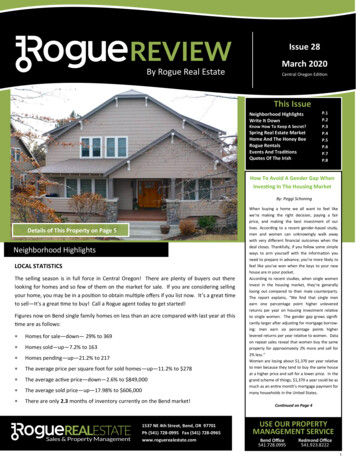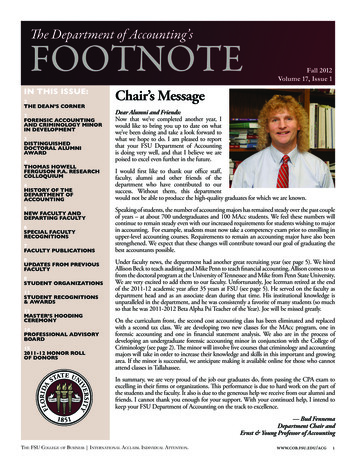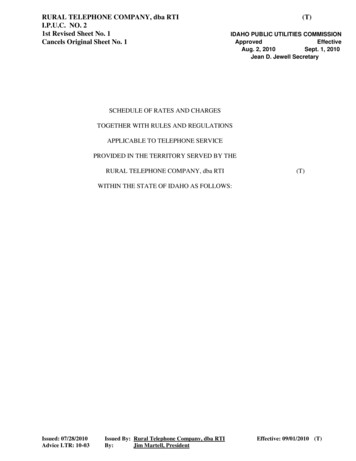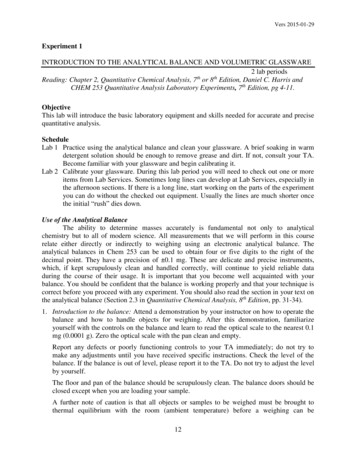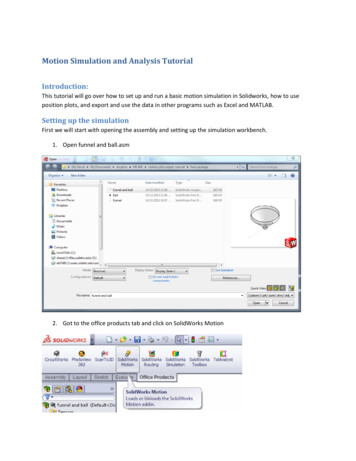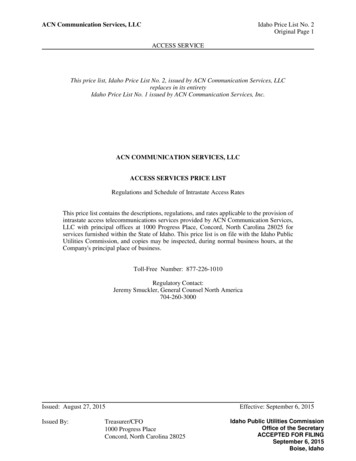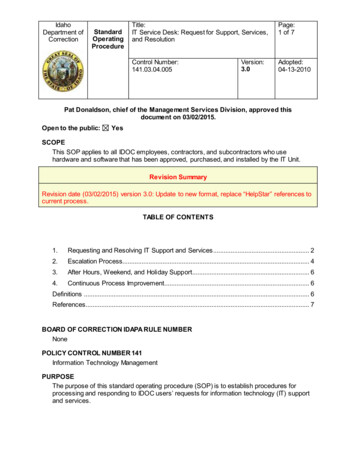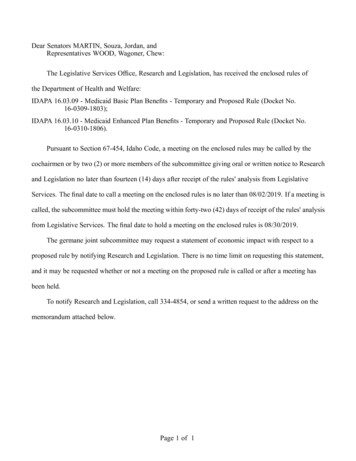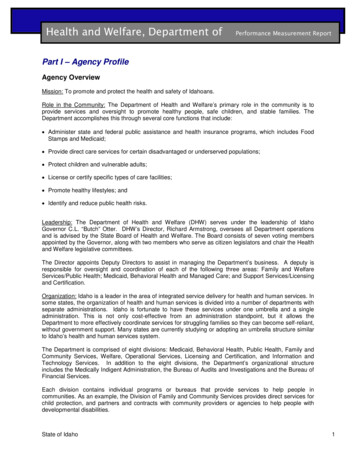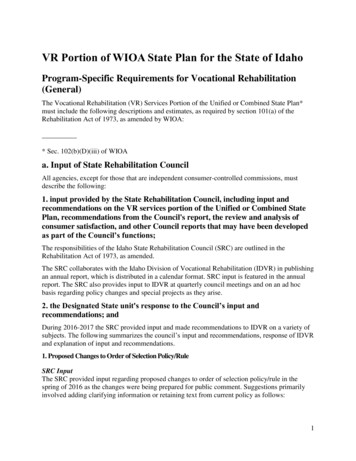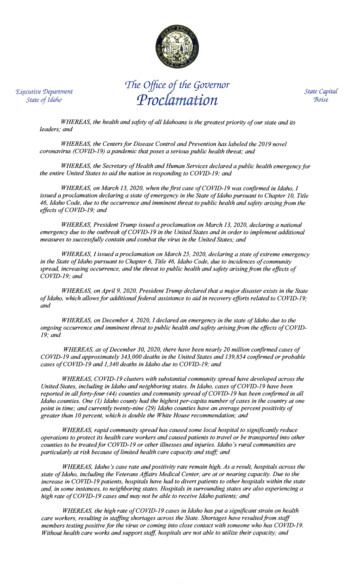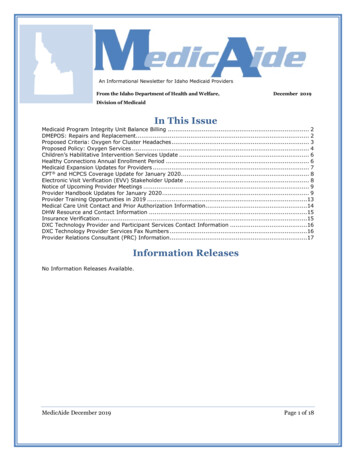
Transcription
An Informational Newsletter for Idaho Medicaid ProvidersFrom the Idaho Department of Health and Welfare,December 2019Division of MedicaidIn This IssueMedicaid Program Integrity Unit Balance Billing . 2DMEPOS: Repairs and Replacement. 2Proposed Criteria: Oxygen for Cluster Headaches . 3Proposed Policy: Oxygen Services . 4Children’s Habilitative Intervention Services Update . 6Healthy Connections Annual Enrollment Period . 6Medicaid Expansion Updates for Providers . 7CPT and HCPCS Coverage Update for January 2020 . 8Electronic Visit Verification (EVV) Stakeholder Update . 8Notice of Upcoming Provider Meetings . 9Provider Handbook Updates for January 2020 . 9Provider Training Opportunities in 2019 .13Medical Care Unit Contact and Prior Authorization Information.14DHW Resource and Contact Information .15Insurance Verification .15DXC Technology Provider and Participant Services Contact Information .16DXC Technology Provider Services Fax Numbers .16Provider Relations Consultant (PRC) Information.17Information ReleasesNo Information Releases Available.MedicAide December 2019Page 1 of 18
Medicaid Program Integrity Unit Balance BillingDuring recent audits, the Medicaid Program Integrity Unit has found instances of providers billingMedicaid participants for covered services. By participating in Medicaid, providers agree to acceptMedicaid allowable amounts as payment in full.IDAPA 16.03.09.210 states in pertinent part:03.Acceptance of State Payment. By participating in the MedicalAssistance Program, providers agree to accept, as payment in full, the amounts paidby the Department for services to Medicaid participants. Providers also agree toprovide all materials and services without unlawfully discriminating on the groundsof race, age sex, creed, color, national origin, or physical or intellectual disability.04.Payment in Full. If a provider accepts Medicaid payment for a coveredservice, the Medicaid payment must be accepted as full payment for that service,and the participant cannot be billed for the difference between the billed amount andthe Medicaid allowed amount.Non-covered services can be billed to the participant. The participant must be informed by theprovider prior to receiving services that the service is not covered. If the participant agrees topay for the service, the provider may bill the participant the entire fee for that service.The Idaho Medicaid Provider Handbook, General Provider and Participant Information, Section1.3.7, outlines non-covered and excluded services and states, in pertinent part:Prior to rendering services that are non-covered or excluded, providers must informparticipants that services are not covered under Medicaid. Providers may only bill noncovered and excluded services and items to the participant if the provider has notified theparticipant of their responsibility to pay in writing prior to rendering services. The noticemust specify the non-covered/excluded service or item, the cost of each service or item,and be signed by the participant. If the participant chooses to obtain services not coveredor excluded by Medicaid, it is the participant’s responsibility to pay for the services.A service that is non-covered or excluded is not reimbursable regardless of the CPT orHCPCS code selected for billing. Non-covered or excluded services billed under an unlistedcode may be subject to recoupment and penalties. See Idaho Medicaid Claim Standards inthe General Billing Instructions, Idaho Medicaid Provider Handbook for more information.Providers who bill Medicaid participants for covered services, or non-covered services without theparticipant’s prior approval, are subject to review which can result in participant refunds andassessed civil monetary penalties.DMEPOS: Repairs and ReplacementEquipment that has exceeded its warranty, is still medically necessary, and is no longerfunctional, may be eligible for reimbursement by Medicaid to replace or repair the item.Equipment should only be replaced when it is more cost effective than repairs, or if the repairedequipment would no longer meet the medical needs of the participant. Prior authorizationrequests must include documentation to support replacement over repair. Equipment that hasreached its reasonable useful lifetime (RUL) does not constitute sufficient reason for replacement.MedicAide December 2019Page 2 of 18
Replacement of equipment or supplies that have been lost as a result of theft require a policereport on file with the supplier, which should be submitted with any resulting prior authorizationrequest. If items are damaged by fire or a natural disaster, etc., then the participant’s home orrenter’s insurance would be the primary payer. If the participant does not have insurance, itshould be documented and provided in any related prior authorization request.Idaho Medicaid has no obligation to repair or replace any piece of durable medical equipment orsupply that has been damaged, defaced, lost, or destroyed as a result of neglect, abuse, ormisuse of the item. Replacement for these circumstances is the responsibility of the participant.An exception may be made for participants under the age of twenty-one (21) through Early andPeriodic Screening, Diagnosis, and Treatment. See the General Provider and ParticipantInformation, Idaho Medicaid Provider Handbook for information on when billing a participant isallowable.A new physician’s order is not necessary for repairs on equipment purchased by Idaho Medicaid.A current physician’s order is required for replacement items to reaffirm medical necessity.Modifiers should be included on claims for equipment to distinguish between repair andreplacement. Modifier RA should be used for replacement items and modifier RB should be usedto denote parts for a repair.Questions about this article may be submitted to the Medical Care Policy Team atMCPT@dhw.idaho.gov.Proposed Criteria: Oxygen for Cluster HeadachesIdaho Medicaid is soliciting comment for a proposed update to the coverage criteria for oxygentreatment of cluster headaches. The proposed coverage criteria is as follows:“Oxygen therapy is only considered medically necessary for cluster headaches that meet thediagnostic criteria of the International Headache Society. The participant must have experiencedfive (5) severe to very severe unilateral headache episodes lasting 15-180 minutes whenuntreated. A severe or very severe headache is defined as one that prevents all usual lifeactivities. The headaches must also correlate with one of the following: Ipsilateral conjunctival injection and/or lacrimation; or Ipsilateral nasal congestion and/or rhinorrhea; or Ipsilateral eyelid edema; or Ipsilateral forehead and facial sweating; or Ipsilateral miosis and/or ptosis; or A sense of restlessness or agitation.A prior authorization (PA) is required for oxygen used to treat a diagnosis of cluster headaches.Approved authorizations are issued for a six-month period. Lab studies are not required.Requests must include documentation of: The participant experiencing the medically necessary criteria above; Failure of other treatments such as dihydroergotamine and sumatriptan (Imitrex); and A successful trial of oxygen therapy in a controlled environment such as the physician’soffice or emergency department.If the participant experiences two (2) contiguous months without a cluster headache incident, theservice is no longer considered medically necessary or reimbursable and must be discontinued.Providers must contact the participant monthly and document if an incident has occurred withinthe past thirty (30) days.MedicAide December 2019Page 3 of 18
Only a stationary gaseous oxygen system (E0424) is considered medically necessary for thetreatment of cluster headaches. When billing for oxygen that is necessary to treat clusterheadaches, the CMN attached to the claim must indicate that the oxygen is for cluster headaches.Only claims with a cluster headache diagnosis of G44.011; G44.019; G44.021; or G44.029 arepayable. See the Payment Methodology subsection of Oxygen Services for other requirementsthat apply.”Comments and questions should be submitted to the Medical Care Policy Team atMCPT@dhw.idaho.gov by January 2nd for consideration.Proposed Policy: Oxygen ServicesIdaho Medicaid is soliciting comment for a proposed update to its policy for oxygen services. Theproposed language is as follows:“Medicaid covers medically necessary oxygen services for participants that meet the DME MACcoverage criteria in local coverage determination (LCD) L33797: Oxygen and Oxygen Equipment.Coverage criteria means the medical, laboratory and Certificate of Medical Necessity CMS484 Oxygen (CMN) requirements. A separate physician’s order from the CMN is not necessary.The CMN and laboratory evidence will remain in effect for one year from the date the test wastaken, unless a lifetime need is indicated. Medicaid does not accept “PRN,” or “As-needed”prescriptions for oxygen. Clinical trials are also not covered. Refer to the following subsections forexceptions to DME MAC requirements. If a participant under the age of 21 does not meet thecriteria, a prior authorization may be requested under the Early and Periodic Screening, Diagnosticand Treatment (EPSDT) program.Exceptions to Lab Studies required by DME MACParticipants under the age of 7-months do not require lab studies or a prior authorization (PA). Ifa participant under the age of 21 does not meet the criteria for lab study results, a PA may berequested under the Early and Periodic Screening, Diagnostic and Treatment (EPSDT) program.Non-covered IndicationsOxygen services are not considered medically necessary for: Angina pectoris in the absence of hypoxemia; Dyspnea without cor pulmonale or evidence of hypoxemia; Severe peripheral vascular disease resulting in clinically evident desaturation in one ormore extremities but in the absence of systemic hypoxemia; and Terminal illness that does not affect the respiratory system.Ventilator Dependent ParticipantsIdaho Medicaid will authorize payment of oxygen services when the participant is ventilatordependent. The participant does not have to meet the PO2 level of 55 mm Hg or arterial oxygensaturation at or below 88 percent to qualify for oxygen supplies. The supplier must use theappropriate diagnosis code to indicate that the participant is ventilator dependent. Participants ona ventilator that provides multi-function respiratory features (E0467) are not eligible for paymentof oxygen equipment (E0424-E0439), contents (E0441-E0444; E0447) or concentrators (E1390E1392), humidifier (E1405-E1406), or the repair of those items (K0739). Billing for these itemsand services separately qualifies as unbundling.Payment MethodologyIdaho Medicaid pays for medically necessary liquid or gas oxygen equipment and contents, or anoxygen concentrator with an all-inclusive monthly rate found on the Idaho Medicaid Numerical FeeMedicAide December 2019Page 4 of 18
Schedule. This rate includes the rental of the delivery system, its contents, maintenance, repair,and any necessary supplies. Payments for equipment also include replacement if repair is not anoption; except when there is irreparable damage from an accident, natural disaster or theft thatmeets the Repairs and Replacement subsection criteria. Separate payments may be made for bothstationary and portable systems when medically necessary. All claims must be billed monthly withthe oxygen information, an attached CMN, and specify actual, inclusive dates of rental.The reasonable useful lifetime (RUL) for oxygen equipment is five (5) years from the time of theparticipant’s receipt. If a participant is on both stationary and portable oxygen, the RUL forequipment will be calculated separately. Suppliers must bill equipment for the first 36 months ofthe RUL, and then for liquid and gas system contents afterwards. The supplier that furnishes thefirst month’s equipment rental must continue to supply all components of the all-inclusive monthlyrate to the participant throughout the RUL unless: The participant relocates outside the supplier’s service area; The participant voluntarily chooses a different supplier; or The supplier receives permission from the Medical Care Unit.A new 36-month period is only permissible with a prior authorization and only in the event theequipment meets the requirements for replacement specified in the Repairs and Replacementsubsection, the participant voluntarily changes suppliers, or as described in the Breaks-in-Servicesubsection. The 36-month period does not reset when: During the RUL equipment is replaced due to wear and tear, malfunction, repair ormaintenance; The RUL is met; During the RUL the participant changes equipment to a new modality of treatment; or As described in the Breaks-in-Service subsection.Participants that own their liquid or gas equipment, receive contents under the all-inclusive monthlyrate except repairs (K0740) and replacement which are separately reimbursable when therequirements in the Repairs and Replacement subsection are met.Supplies and maintenance are only separately payable for oxygen concentrators, and only if theparticipant owns the equipment or the initial 36-month period has been completed. Maintenance isreimbursable once every six months beginning in the 42nd month. See the Maintenance subsectionfor more information.For participants who are dually eligible for both Medicare and Medicaid, all Medicare policies mustbe followed. After 36 months of Medicare payment, the provider may not shift payment for theequipment to Medicaid.Providers should bill the following modifiers on claims for oxygen supplied through stationaryequipment when the prescribed liters per minute are less than one (1) or more than four (4):ModifierQEDescriptionReimbursementPrescribed amount of oxygen is less than 1 liter per minute Paid at 50%.(LPM).QFPrescribed amount of oxygen is greater than 4 liters perPaid at 150%.minute (LPM) and portable oxygen is prescribed.QGPrescribed amount of oxygen is greater than 4 liters perPaid at 150%.minute (LPM).Breaks-in-ServiceIf a break-in-service occurs without a break in medical necessity, billing should pause untilservice is re-established. Re-established service then continues off where it was before the break.MedicAide December 2019Page 5 of 18
If oxygen becomes no longer medically necessary during the initial 36-month rental period, butnew medical necessity is later established and: It hasn’t been more than sixty (60) days plus the remainder of the rental month theydiscontinued oxygen, the service period continues from where it left off. It has been more than sixty (60) days plus the remainder of the rental month theydiscontinued oxygen, a prior authorization will be required to start a new 36-monthperiod.If oxygen becomes no longer medically necessary during months 37-60, but new medicalnecessity is later established a new 36-month rental period does not begin. The supplier of theequipment during the 36th month re-establishes service as if there wasn’t a break. A supplier’sfailure to bill is not a break-in-service and cannot be used to begin a new RUL.”Comments and questions should be submitted to the Medical Care Policy Team atMCPT@dhw.idaho.gov by January 2nd for consideration.Children’s Habilitative Intervention Services UpdateOnly July 1, 2019, Children’s Habilitative Intervention Services (CHIS) changed from being aDevelopmental Disabilities waivered service to a State Plan benefit. These services includeBehavioral Intervention, Habilitative Skill, and Interdisciplinary Training, and are required to haveprior authorization from our Quality Improvement Organization, Telligen, before providing andbilling for the service.For more information on how to prior authorize CHIS through Telligen, please review the newFrequently Asked Questions on Telligen’s lt/files/documents/Idaho ChildrenHabilitationInterventionServices FAQ.pdfHealthy Connections Annual Enrollment PeriodJanuary - February 2020Healthy Connections (HC) implemented a member Fixed Enrollment policy effective July 1, 2019.This change is designed to:1. Promote a long-term provider-patient relationship, resulting in better care coordination.2. Support the transition to a value-based model of care.Important HC Fixed Enrollment Reminders: There are two periods of time that enrollment requests to change a member’s HC Cliniccan be processed for any reason:o Annual Enrollment Period - January and February each year.o The grace period of 90 days following enrollment to a new HC Clinic. Change requests for the Annual Enrollment Period will not be accepted prior to January 1steach year. Enrollment and change requests must be submitted by the member or their authorizedrepresentative. HC PCPs or other providers may assist HC members in transmitting theenrollment forms, as long as the form is signed by the member or their authorizedrepresentative.MedicAide December 2019Page 6 of 18
Requests for changes outside of the Annual Enrollment or Grace Period must meet specialcircumstance criteria and will not be effective until approved by HC staff.A list of special circumstances can be found in the Idaho Medicaid Provider Handbookunder the General Provider and Participant information under the Healthy Connectionssection (Section 1.5.3) along with a full explanation of the Fixed Enrollment process.Important updates to Special Circumstances When requesting a different HC Clinic than one assigned by HC Staff, the assignment musthave occurred within the past twelve months to be eligible for this special circumstance. New special circumstance – Members of the same household may request enrollment atthe same HC clinic.ATTENTION HC PROVIDERS - To ensure accurate member enrollment, it is important for HCproviders to timely inform HC Staff if your clinics ability to accept new Medicaid patient changes.This Fixed Enrollment policy is being implemented to comply with the IDAPA 16.03.09.562.02rule change effective 7/1/2019. If you have any questions regarding this change, please contactyour regional Healthy Connections Representative or the Healthy Connections Consolidated Unitat 888-528-5861.Medicaid Expansion Updates for ProvidersOpen Enrollment Progress ReportEnrollment totals for the first 22 days of open enrollment are in, andMedicaid has enrolled 42,386 of the 91,000 adults estimated to beeligible for expansion.Expansion Website ChangesThe entire expansion site at https://medicaidexpansion.idaho.gov/ hasbeen reorganiz
Children’s Habilitative Intervention Services Update .6 Healthy Connections Annual Enrollment Period . Idaho Medicaid has no obligation to repair or replace any piece of durable medical equipment or supply that has been damaged, defaced, lost, or destroyed as a result of neglect, abuse, or .
